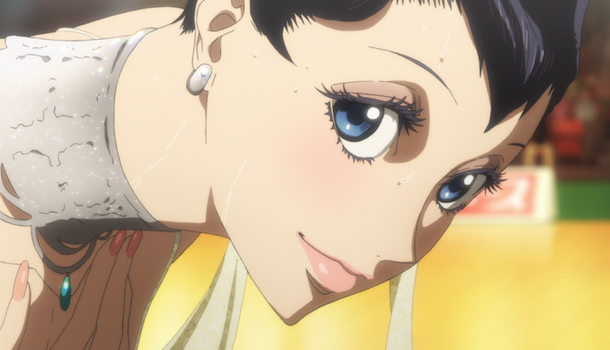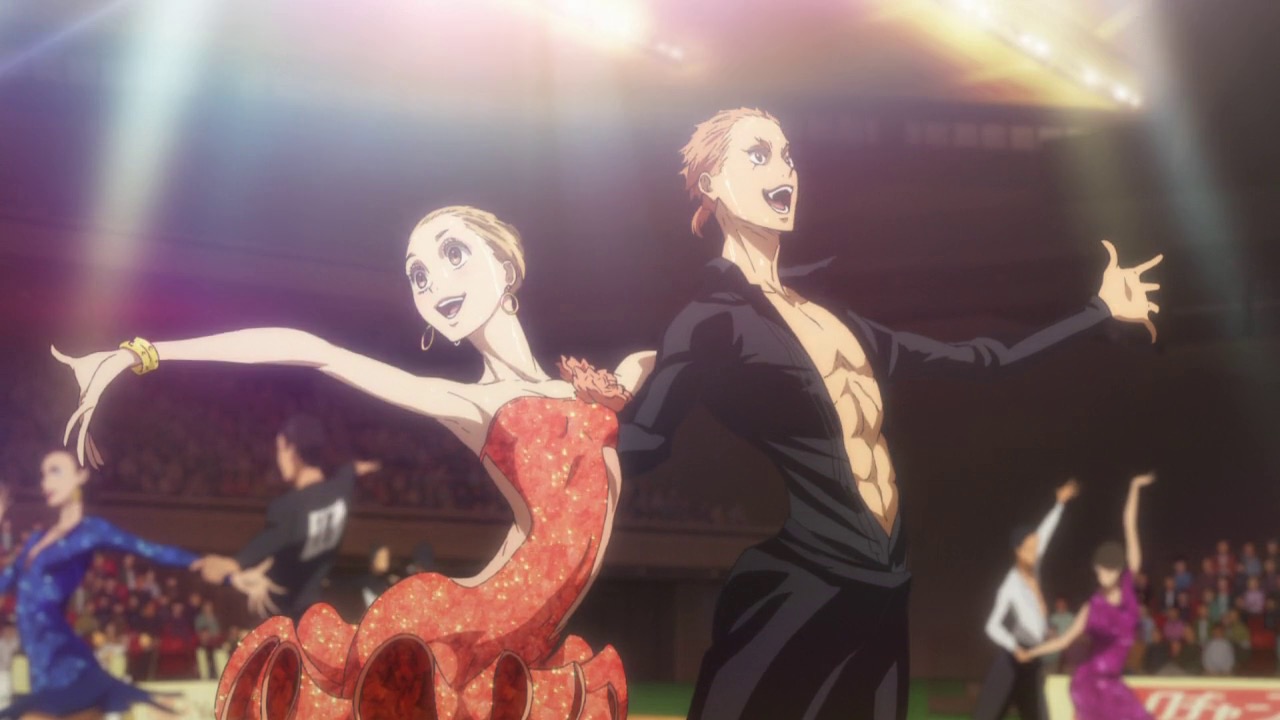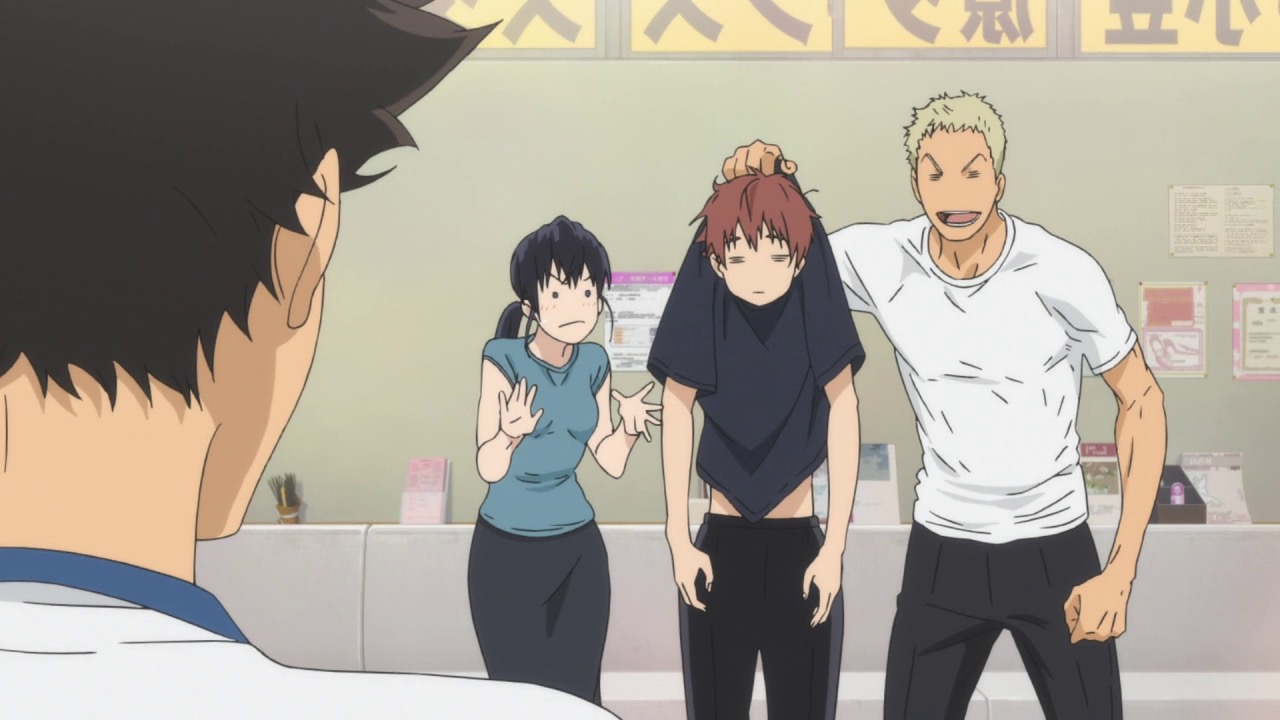
Written by Tom Mcllroy on 29 Jul 2019
Distributor Anime Ltd • Certificate 15 • Price £44.89
The thing that I really enjoy about sports anime shows is how they often get you wanting to take up the sport in question. Far from escapist adventures, we’re often tempted to bring them into our actual lives in a way few other genres can (merchandise excluded, of course). Welcome to the Ballroom, produced by Production I.G, aired in the summer of 2017, and adapted from Tomo Takeuchi‘s now very closely followed manga is, for me at least, the epitome of that contagious type of show. It doesn’t just invite us into the world of ballroom dancing, it also builds a real appreciation for the athleticism of those who live there, all thanks to a great plot, spirited characters, and a stunning visual style.
The story follows Tatara Fujita, an aimless middle schooler who is finding himself compelled to find a purpose and direction to his life. He longs to be good at just one thing, and is woefully aware of how other students, such as the enchanting Shizuku Hanaoka, seem to have everything figured out. However, when Tatara is later confronted by his school’s bullies outside Ogasawara Dance Studio, fate takes over. Kaname Sengoku, one of the studio’s charismatic residents, rescues Tatara and, seeing this chance encounter as unquestionable proof of his interest in ballroom dancing, proceeds to drag the young student into a world that changes everything.
Despite being a shōnen (i.e. aimed at younger adults), I do think Tatara’s story is one that can appeal to many of us. That’s because it’s not just about finding a passion in life - which Tatara actually discovers quite quickly in this show - but more so about the struggle to master it under the gaze of people far more experienced. In that sense, it’s a tale that should resonate with all of us and, as Tatara shows us, it’s a journey that often has no defined destination beyond a sense of self-fulfilment.
That said, in many ways Welcome to the Ballroom’s plot does follow in the footsteps of its fellow sports shows; over twelve episodes, we see Tatara grow not through spectacular and unexpected wins, but painful losses and struggle. We are just as aware of his own inferiority as he is, but it’s his desire to play the part and to stand with his peers that sees him throw himself in again and again, entertaining and endearing him to us in equal measure.

Speaking of character, this show brings together a really captivating and well-suited cast for this first arc and, as you may expect, they come in pairs. We’re quickly introduced to Sengoku, the ever-confident Latin world dancer who takes Tatara under his wing with his tough-love method and Tamaki Tsuburaya, the owner of Ogasawara Dance Studio, who counters Sengoku’s approach with her much more maternal one. Karen Banba and Tomichika Jinbo, both instructors at the studio, form the show’s lively comedic side-pair and help to bridge Tatara’s (and our) understanding of ballroom dancing, while also stirring up the funny side of his inexperience.
However, it’s Kiyoharu Hyōdō and Shizuku Hanaoka and, later, siblings Gaju Akagi and Mako Akagi who take to the floor as Tatara’s rivals. Both of these couples are prodigies in their fields, having danced from a very young age. So, as you would expect, there’s a fair amount of ego on the floor too. This makes each battle one of wills and pride as much as stamina, and its Tatara’s ability to win over the hearts and minds of his competition, in spite of his slightly lacklustre abilities, that form the core of this first arc.
That said, it’s not all about Tatara’s own struggles; every character is wrestling with emotional issues that can only be settled in the ballroom. In fact, what really impressed me was how well these personal struggles and their resolutions are interwoven into their development as dancers. Inner monologues, flashbacks and spectacular motifs all play out in their dancing, circling figuratively and literally around the shows central concept - expression. All of our characters want to find their inner selves, to express it on the dance floor and, just as importantly, to be seen for who they really are. This idea comes together beautifully in the climax of this first half as one of our characters blooms into an entirely new person and dancer simultaneously, a revelation for them as much as it is for those watching on.
Thankfully, all of the cast discover new ways to express themselves both on and off of the dance floor, whether it be as mentors, partners or individuals, and we close Part 1 with characters who are much more affirmed of who they want to be, for themselves and each other. Yet, just as importantly, they also know how they want to express that true version of themselves to the world, and to be seen for who they really are.

Lingering on the story for a moment longer, it’s important to say that Welcome to the Ballroom does a superb job of highlighting the complexity and drama of ballroom dancing; no-one ever has complete control of the floor as the momentum shifts suddenly from second-to-second. It’s a trait shared by many other sports anime but, in a world where presentation is just as important as actual performance, this show keeps us very much on our toes.
But what truly sets Welcome to the Ballroom apart, in my view at least, is its incredible visual style; one that stands very much on the shoulders of the show’s manga artist, Tomo Takeuchi. She has a profound intensity and energy in her work, made all the more so through her use of fine lines to emphasise the powerful kinetics at play on the dance floor. It’s a style that’s simply perfect for this setting and I fully recommend you check out the manga for yourself, even if you have seen this anime already.
Of course, I also applaud Production I.G for tastefully bringing Tomo’s work to life. One the one hand, they show a great deal of respect for the show’s source; there are quite a few moments when the motion stops and the tension is played out frame by frame, the manga coming to life in a more literal sense. On the other hand, however, the studio stamps its mark on the show with intense moments of fluid footwork and dance, particularly when the tempo and drama kick into high gear. It’s hard to stress what a challenge this must have been for animators, and they do a wonderful job of celebrating Tomo’s superb work while pushing the boundaries that a manga simply can’t.

As you may expect, accentuated dancing also calls for some similarly accentuated characters; long necks, arms and legs are aplenty in this show, and most of our cast possess physiques that I can only describe as ‘graceful fan-service’. However, I don’t mean that as a slight; some may feel that these designs seems a little uncanny, but they all allow for a far greater emphasis on the forms and silhouettes of the dancers - a key element of the sport - while also giving the show a standout quality. Personally, I think the approach is perfect for the story Welcome to the Ballroom is trying to tell, and I’m relieved that, since ballroom dancing is a sport based on physique, it doesn’t look to score too many cheap goals with more traditional fan-service; it’s a classy anime dealing with a classy sport.
There’s not really enough time to fully praise the visual aesthetics of this show; there’s a wonderful use of visual motifs, and a superb vibrancy of colour during the emotional climaxes (something the show cranks up to eleven later in Part 2). What I’m most relieved to say, though, is that the anime certainly does not eclipse its source. Both Tomo’s manga and Production I.G’s adaptation energise the original story with their own unique touches and, much like dancers in a ballroom, put on performances that are equally worth your attention.
Touching ever so briefly on the shows openings and closings, there’s a number of nice contrasts and complements at play. Firstly, it’s worth noting that the series actually introduces the second opening and close on episode 12, so as to mark the beginning of the show’s second arc (and that’s why I wanted to touch on both in this already-rather-long review).
Both openings are particularly interesting when you compare them; for instance, there’s a great contrast between the squeaky clean, colourful and bouncy first opening, which marks Tatara’s wondrous journey into the world of ballroom dancing, and the gloomy but equally energetic second one that hints towards the tense realities and politics of that world. Similarly, both closing animations do a great job of bringing our focus back onto the partner dynamic, ending each episode with a playful and upbeat reminder that dance is about bringing people together at the end of the day, not tearing them apart.
The soundtracks for all four are also superb, and remind us that ballroom dancing is not all about slow, acoustic music, but is rather a much broader church. The bouncy, fast-paced openings are played by rock group UNISON SQUARE GARDEN, and both closings are performed by Mikako Komatsu. Interestingly, while both opening songs are similar, lively tracks, the closings are nicely contrasted. The first is a slower, more acoustic melody, while the second is far more peppy, invoking a nice distinction between traditional and modern styles that is heavily explored as a theme in the show’s second half. It’s a really subtle aspect, but one that shows how well Welcome to the Ballroom plays to all it’s different aesthetics when exploring its message and, as mentioned earlier, how Production I.G has cleverly put their mark on the show’s deeper themes.

And very lastly, I wanted to quickly talk about Anime Ltd’s Collector’s Edition release of Welcome to the Ballroom’s first half, which arrived shortly after the review disks. Over time, I’ve got quite fond of their slimmer format CE’s and I generally like how they’ve similarly approached this one, with a clear focus on the visual design that has drawn so many fans to the series. Included inside are four excellent character art cards, an A3 poster of the official promotional art, and a 24-page booklet that includes character bios, frames from the show, and director commentary on the first opening and closing animations. The interviews are particularly insightful, and reveal some of the unseen difficulties and hidden meanings behind these often-skipped moments, again showing what a great deal of love and attention has gone into this production.
My one very small critique, however, is that I feel Anime Ltd have reached ever so slightly too far in respect to the showcasing the show's art. The booklet is slightly smaller than A5, not big at all, and it means that much of the frame-by-frame art is squeezed into packed corners of the pages. For some frames this is fine, but for others we lose a great deal of detail - finer costume details or expressions, for example - that really bring those particular moments to life. It’s still an amazing addition, but one that seems uncomfortably crammed; the booklet could have easily done with a few more pages in order to give those time-worthy images enough room to breathe. Overall, though, this is still a great collector’s item, and one that I am glad to have picked up.
Welcome to the Ballroom easily sits as one of my favourite anime shows of all time, and this first half reveals many of the reasons why. It takes an incredibly obscure sport and uses it to tell a relatable, compelling, funny and visually spectacular story that only gets stronger in its second half. Again, much of this stands on the shoulders of Tomo Takeuchi and the her manga, which is undoubtedly as worthy of your time as this show is. The anime, though, is as close to perfect as it gets for me, and I can’t commend it enough. Try it for yourself; much like Tatara, I think the world of ballroom dancing may just surprise you.
by Ross Locksley on 21 Dec 2025
by Ross Locksley on 25 Nov 2025
by Ross Locksley on 24 Nov 2025
by Ross Locksley on 11 Nov 2025
by Ross Locksley on 08 Nov 2025
by Ross Locksley on 07 Nov 2025
by Ross Locksley on 05 Nov 2025
by Jamie Morris on 27 Oct 2025